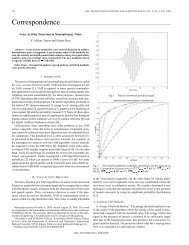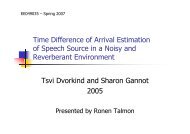Thesis (PDF) - Signal & Image Processing Lab
Thesis (PDF) - Signal & Image Processing Lab
Thesis (PDF) - Signal & Image Processing Lab
You also want an ePaper? Increase the reach of your titles
YUMPU automatically turns print PDFs into web optimized ePapers that Google loves.
5.2. IMAGE PROCESSING ON TREE SEMILATTICES 71<br />
mappings belong to that subtree. But x lies outside a shape left by an erosion<br />
operation on �<br />
v ′ �v R(v′ ) using the structure element B. It means that when B was<br />
applied to x, it included M−B(x) vertices, and one of that vertices was outside the<br />
subtree of v. So, ˆ M(x) could not belong to �<br />
v ′ �v ˆ R(v ′ ).<br />
In the second case, x belongs to �<br />
v ′ �v R(v′ ) but doesn’t belong to �<br />
v ′ �v ˆ R(v ′ ). In<br />
a similar way as described above, all source M−B(x) vertices belong to �<br />
v ′ �v R(v′ ),<br />
so that ˆ M(x) must belong to the same subtree - �<br />
v ′ �v ˆ R(v ′ ).<br />
The above proposition suggests that one way of implementing the tree-representation<br />
erosion (assume the list of all flat zones of f and a spanning tree t are given) is by:<br />
1. Associating to each item v of the list the set of points ¯ R(v) △ = �<br />
v ′ �v R(v′ ), i.e.,<br />
the union of all flat zones that are equal or greater than v in the tree t.<br />
2. Eroding ¯ R(v) for each v in the list.<br />
3. Assigning the gray level of v for all pixels in ˆ R(v) △ = ¯ R(v) \ �<br />
v ′ �v ¯ R(v ′ ).<br />
5.2.2 Examples and Particular Cases<br />
RAG’s and Spanning Trees<br />
In order for the tree transform to be invertible, τ should be such that it assigns a<br />
common label to each flat zone of f. This is because τ −1 maps each label to a single<br />
gray value. This suggests that special attention should be paid to the flat zones of f.<br />
One way of addressing the flat zones of a given image is by considering its Regional<br />
Adjacency Graph (RAG). The RAG is a graph, where V is the set of all flat zones of<br />
the image, and E contains all pairs of flat zones that are adjacent to each other.<br />
A spanning tree is a subgraph of a RAG that should, obviously, be a tree, and<br />
have the same vertex set V as the RAG. A spanning tree creates a hierarchy in the<br />
RAG, defining father/son relationships between adjacent flat zones.<br />
BTV and Shape Trees<br />
The BTV tree described in chapter 3, is built from the RAG using minimal topo-<br />
graphic distance criteria for building the tree t. The vertex set of the BTV tree is the
















